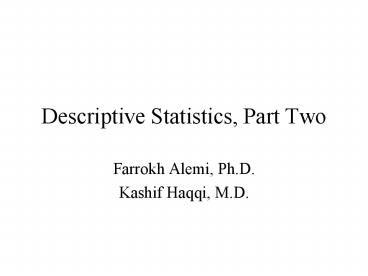Descriptive Statistics, Part Two PowerPoint PPT Presentation
1 / 26
Title: Descriptive Statistics, Part Two
1
Descriptive Statistics, Part Two
- Farrokh Alemi, Ph.D.
- Kashif Haqqi, M.D.
2
Table of Content
- Objectives
- Frequency distribution
- Categorical
- Ungrouped
- Grouped
- Histogram
- Cumulative frequency
- Pie chart
- Bar chart
3
Objectives
- Given a set of nominal or ordinal data, interpret
its frequency distribution, pie chart, and bar
chart. - Given a set of numerical data, interpret its
frequency distribution, cumulative frequency
distribution, and histogram. - Given a set of numerical data, interpret the
meaning of its range, variance, standard
deviation, and coefficient of variation.
Return to Table of Contents
4
Organizing Data
- Data when collected in original form is called
raw data. - For example
5
Frequency Distribution
- The researches organizes the raw data by using
frequency distribution. - The frequency is the number of values in a
specific class of data. - A frequency distribution is the organizing of raw
data in table form, using classes and frequencies.
Return to Table of Contents
6
Frequency Distribution Cont.
- For the first data set, a frequency distribution
is shown as follow
7
Types of Frequency Distribution
- There are three basic types of frequency
distribution - Categorical
- Ungrouped
- Grouped
Return to Table of Contents
8
Categorical Frequency Distribution
- The categorical frequency distribution is used
for data that can be placed in specific
categories, such as nominal or ordinal data. - For example, data such as political affiliations,
religion affiliations, or major field of study
would use categorical frequency distribution.
Return to Table of Contents
9
Example
- The blood type of different students
10
Example Cont.
11
Ungrouped Frequency Distribution
- When the range of data is small, the data must be
grouped into classes that are not more than one
unit in width.
Return to Table of Contents
12
Example
- The range in the example is Rhighest value
lowest value 11 4 7 - Since the range is small classes consisting of
single data value can be used.
13
Example Cont.
14
Grouped Frequency Distribution
- When the range of the data is large, the data
must be grouped into classes that are more than
one unit in width.
Return to Table of Contents
15
Example
16
Example Cont.
- In this distribution, the values 1 and 3 of the
first class are called class limits. - 1 is the lower class limit and 3 is the upper
class limit.
17
Histogram
- The histogram is a graph that displays the data
by using vertical bars of various heights to
represent the frequencies.
Return to Table of Contents
18
Histogram in Excel (Steps)
- Open the tools menu, choose the data analysis
command and chose histogram from the analysis
tools list box. - Input range enter the reference for the range of
cells containing the data. - Bin range enter the reference of cells
containing the values that separate the
intervals, including the labels. (They must be in
ascending order).
19
Steps Continued
- Labels check this box to indicate that labels
have been included in the references for the
input range and bin range. - Out put range enter the reference for the cell
you want out put to appear. - Chart output check this option to obtain a
histogram chart in addition to the frequency
distribution table on the worksheet.
20
Create a histogram for the following data5, 6,
4, 7, 5, 9, 11, 12, 4, 5, 6, 7, 9, 19
- Do this in Excel
21
Cumulative Frequency
- The cumulative frequency is the sum of the
frequencies accumulated up to the upper boundary
of a class in the distribution. - They are used to visually represent how many
values are below a certain upper class boundary.
Return to Table of Contents
22
Example of Cumulative Frequency Distribution
23
Pie Chart
- A pie chart is a circle that is divided into
sections according to the percentage of
frequencies in each category of the distribution.
Return to Table of Contents
24
Example
25
Example Cont.
26
Bar Chart
- A bar chart is a broader concept than histogram.
- A bar chart may be used to display concepts other
than frequency of an observations. For example,
a bar chart may display the average exam results. - Histogram is a bar chart of frequency
distribution.
Return to start

